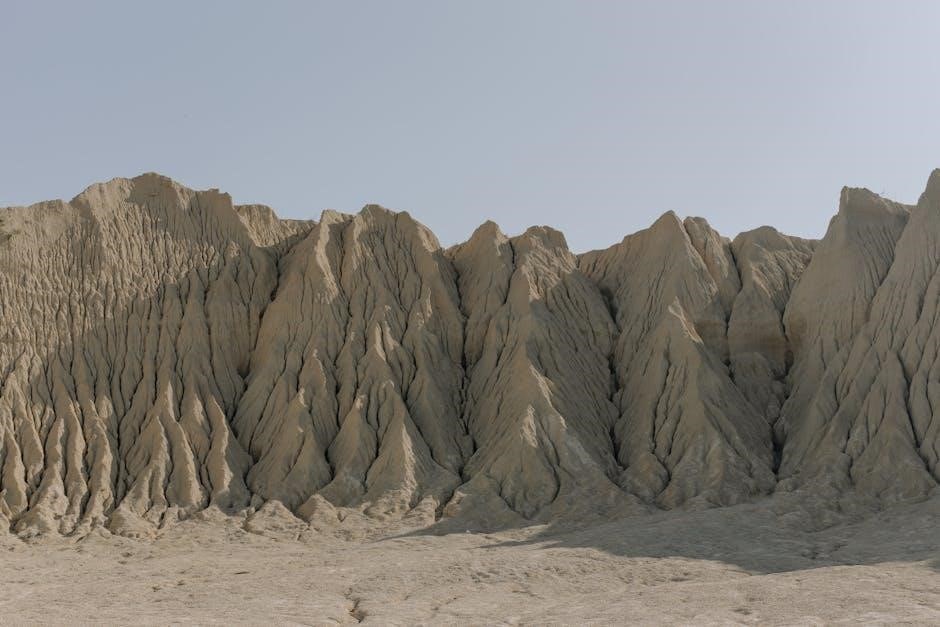1.1 Overview of the Poem’s Significance
T.S. Eliot’s The Waste Land (1922) is a landmark modernist poem exploring disillusionment and spiritual decay in a post-WWI world. Divided into five sections, it blends myth, allusion, and fragmented narratives to reflect societal chaos and the search for meaning. Available as a free eBook via Project Gutenberg, it remains a pivotal work in literary history.
T.S. Eliot’s The Waste Land (1922) is a modernist masterpiece exploring disillusionment and spiritual decay in a post-WWI world. Its fragmented structure and multiple narrators reflect societal chaos, while its rich allusions to mythology and literature underscore the search for meaning. The poem’s five sections create a mosaic of themes, from the decay of modern life to the quest for spiritual renewal. As a foundational work of modernism, it challenges traditional narrative forms, offering a profound critique of civilization. Its enduring relevance is evident in its continued study and adaptation, making it a cornerstone of literary analysis and academic discourse.
1.2 Historical Context of the Poem
T.S. Eliot’s The Waste Land was published in 1922, amidst the social and cultural upheaval following World War I. The war’s devastating impact left Europe in a state of spiritual decay and disillusionment, themes central to the poem. Eliot reflected the era’s moral and existential crises, capturing the fragmentation of society and the search for meaning in a broken world. The poem’s historical context is deeply tied to the post-war zeitgeist, exploring the collapse of traditional values and the rise of modernity. This backdrop of collective despair and intellectual turmoil shaped Eliot’s vision of a wasteland, both literal and metaphorical.

Structure and Organization of “The Waste Land”
The Waste Land is divided into five distinct sections, each exploring different themes and narratives. The poem’s structure, with multiple shifting voices and locations, reflects its modernist experimentation and fragmented form, mirroring the chaos of the post-WWI world.
2.1 The Five Sections of the Poem
T.S. Eliot’s The Waste Land is structured into five distinct sections, each contributing to the poem’s complex tapestry. The first section, “The Burial of the Dead,” introduces themes of disillusionment and renewal, while “A Game of Chess” delves into emotional and psychological turmoil. “The Fire Sermon” explores spiritual decay, referencing mythical and historical narratives. The fourth section, “Death by Water,” symbolizes rebirth and transformation, and the final section, “What the Thunder Said,” concludes with a meditation on despair and the hope for redemption. This structure reflects Eliot’s modernist experimentation and thematic depth.
2.2 The Use of Multiple Narrators and Voices
T.S. Eliot’s The Waste Land employs multiple narrators and voices to create a fragmented, polyphonic narrative. This technique reflects the chaos and disillusionment of the post-WWI world, as different voices and perspectives intersect and collide. The poem shifts between locations and speakers, blending mythological, historical, and modern references. Eliot’s use of diverse voices underscores the search for meaning in a fractured society, mirroring the dislocation of modern life. This layering of narratives adds complexity, inviting readers to piece together the poem’s themes and symbolism, while emphasizing the subjective nature of experience in a fragmented world.

Themes and Motifs in “The Waste Land”
T.S. Eliot’s The Waste Land explores themes of disillusionment, spiritual decay, and the search for meaning in a fractured post-WWI world, using myth and allusion to illustrate these motifs.
3.1 Disillusionment and Spiritual Decay
T.S. Eliot’s The Waste Land vividly portrays a society plagued by disillusionment and spiritual decay, reflecting the post-WWI era’s moral and emotional paralysis. The poem’s imagery, such as the barren land and the “stony rubbish” of modern life, underscores the absence of hope and renewal. Eliot contrasts the promise of spring with the despair of a decaying world, where humanity is trapped in a cycle of meaningless existence. This theme is reinforced by allusions to Dante’s Inferno, symbolizing a spiritual wasteland devoid of redemption. The poem’s bleak vision captures the fractured psyche of a generation, emphasizing the disconnection between modernity and transcendence.
3.2 The Search for Meaning in a Post-WWI World
T.S. Eliot’s The Waste Land captures the profound disillusionment and existential crisis of the post-WWI era. The poem reflects a world shattered by war, where traditional beliefs and values have collapsed. Eliot’s fragmented narratives and allusions to myth and history symbolize the search for meaning in a spiritually barren landscape. The poem’s imagery of a “dead land” and its juxtaposition of mythological references with modern despair underscore the struggle to find purpose in a fractured society. This theme resonates as a universal quest for renewal and transcendence, echoing humanity’s eternal search for significance amidst chaos and destruction.
3.3 The Role of Myth and Allusion
T.S. Eliot’s The Waste Land is rich in mythological and literary allusions, drawing from sources like Dante’s Inferno, Shakespeare, and ancient myths. These references serve to underscore the poem’s themes of spiritual decay and the search for meaning. Eliot’s use of figures such as Tiresias and the Fisher King myth symbolizes the universal human struggle with disillusionment and redemption. By weaving these allusions into the text, Eliot creates a layered narrative that transcends time and culture, reflecting the chaos of the modern world while invoking timeless truths. This technique emphasizes the interconnectedness of human experience across history and literature.
Cultural and Literary Allusions
Eliot’s The Waste Land is rich in cultural and literary references, drawing from Dante, Shakespeare, and mythological figures, creating a dense, layered narrative reflecting modernist experimentation and historical depth.
4.1 The Influence of Dante’s “Inferno”
Dante’s Inferno deeply influences Eliot’s The Waste Land, as seen in its structural and thematic elements. Eliot alludes to Dante’s journey through hell, using imagery like the “Unreal City” to mirror Dante’s depiction of a spiritual wasteland. The poem’s fragmented narrative anduse of multiple voices echo Dante’s layered storytelling. Eliot also references Dante’s themes of moral decay and redemption, reimagining them in a modern context. Specific allusions, such as the “voyage of Odysseus,” further highlight Dante’s influence on Eliot’s exploration of disillusionment and the search for spiritual renewal in a post-WWI world.
4.2 References to Shakespeare and Other Classical Works
Eliot’s The Waste Land is rich with allusions to Shakespeare and classical literature, enhancing its layered meaning. Phrases like “O, O, O, O” echo Shakespeare’s dramatic style, while references to Hamlet and A Midsummer Night’s Dream reflect themes of disillusionment and decay. Eliot interweaves these classical elements to underscore the poem’s exploration of spiritual and cultural collapse. Shakespearean motifs, such as the tragic hero’s struggle, are reimagined in a modern context, adding depth to the narrative. These references not only highlight Eliot’s scholarly background but also invite readers to connect the poem’s modernist experimentation with timeless literary traditions, enriching its interpretative scope.
4.3 The Use of Mythological Figures
Eliot’s The Waste Land heavily incorporates mythological figures to underscore its themes of disillusionment and spiritual decay. The Fisher King, a figure from Arthurian legend, symbolizes a land in need of renewal, while Tiresias, the blind prophet from Greek mythology, embodies the search for truth in a fractured world. These mythological allusions serve as a bridge between ancient narratives and modern existential crises, enriching the poem’s layered meaning. By invoking these figures, Eliot critiques the spiritual barrenness of post-WWI society, using myth to convey the universal human struggle for redemption and understanding in a chaotic world.

Poetic Style and Technique
Eliot’s modernist masterpiece employs fragmentation, collage, and allusions to create a layered, disjointed narrative, reflecting the chaos of post-WWI society through experimental form and imagery.
5.1 Modernist Experimentation
T.S. Eliot’s The Waste Land epitomizes modernist experimentation through its non-linear structure and rejection of traditional narrative forms. The poem’s fragmented imagery and disjointed voices mirror the spiritual decay of post-WWI society. Eliot’s use of collage technique, blending snippets of myth, literature, and culture, creates a dense, multilayered text. This experimentation not only challenges conventional poetry but also reflects the chaos and disillusionment of the era. The poem’s modernist style, as seen in its free verse and allusions, demands active reader engagement, making it a cornerstone of 20th-century literary innovation.
5.2 The Use of Fragmentation and Collage
Eliot’s The Waste Land employs fragmentation and collage to reflect the disintegration of modern life. The poem’s structure, composed of disjointed voices and imagery, mirrors the spiritual decay of post-WWI society. By collaging references to myth, literature, and culture, Eliot creates a layered narrative that resists linear interpretation. This technique forces readers to piece together meaning, echoing the chaos of the era. The fragmentation of language and form underscores themes of disillusionment, while the collage of allusions highlights the search for connection in a fractured world. This method revolutionized poetry, making The Waste Land a defining work of modernism.
5.3 The Role of Imagery and Symbolism
In The Waste Land, Eliot masterfully employs imagery and symbolism to convey the spiritual and cultural decay of modern society. The wasteland itself serves as a central symbol, representing a world devoid of meaning and fertility. Images like the “cruellest month” of April and the “dead land” juxtapose natural renewal with emotional barrenness. Eliot’s use of symbols, such as the Grail legend and the “shadow,” evokes a search for redemption amidst fragmentation. These elements create a rich, layered narrative, inviting readers to interpret and connect the poem’s diverse allusions. The imagery and symbolism are essential to the poem’s exploration of disillusionment and spiritual renewal;

The Waste Land’s Impact and Legacy
The Waste Land revolutionized modernist literature, influencing countless writers and scholars. Its exploration of disillusionment and spiritual decay remains timeless, with PDF editions and study guides widely accessed, ensuring its enduring academic and cultural relevance.
6.1 Influence on Modernist Literature
T.S. Eliot’s The Waste Land is a landmark of modernist literature, reshaping poetic form and technique. Its fragmented structure and collage method inspired generations of writers, influencing works by Ezra Pound, Virginia Woolf, and others. The poem’s experimental style challenged traditional narratives, fostering a new era of literary innovation. Available as a free PDF via Project Gutenberg, its accessibility has ensured its enduring influence. Scholars and writers continue to draw from its themes of disillusionment and spiritual decay, solidifying its role as a cornerstone of modernist thought and artistic expression. Its impact remains unparalleled in 20th-century literature.
6.2 The Poem’s Enduring Relevance
T.S. Eliot’s The Waste Land remains a timeless masterpiece, resonating with themes of disillusionment and spiritual decay. Its exploration of post-WWI societal chaos continues to reflect universal human struggles. The poem’s fragmented structure and mythological allusions offer layered interpretations, appealing to diverse readers. Available as a free PDF, its accessibility has ensured its enduring relevance. Scholars and readers alike revisit its themes of existential crisis and the search for meaning, making it a cornerstone of modernist literature and a vital text for understanding the 20th century’s cultural and philosophical shifts. Its influence endures, ensuring its place in literary history.
6.3 The Role of “The Waste Land” in Academic Studies
T.S. Eliot’s The Waste Land is a cornerstone of academic literary studies, offering rich material for critical analysis. Its complex structure, layered allusions, and modernist experimentation make it a focal point for scholars exploring themes of disillusionment and cultural decay. Universities worldwide include the poem in syllabi, emphasizing its historical and philosophical depth. The availability of critical editions, such as the Norton Critical Edition, and numerous scholarly essays provide students with comprehensive tools for interpretation. Its intertextual and mythological dimensions encourage interdisciplinary approaches, cementing its role as a foundational text in literary academia and ensuring its continued relevance in educational settings.

Reception and Criticism
T.S. Eliot’s The Waste Land sparked controversy upon release, with critics divided over its modernist style and fragmented structure. Despite initial skepticism, it is now hailed as a landmark of 20th-century literature, influencing countless academic studies and remaining central to modernist scholarship.
7.1 Initial Reception and Controversy
T.S. Eliot’s The Waste Land was met with both fascination and skepticism upon its 1922 release. Critics struggled with its fragmented, modernist style and eclectic allusions, finding it challenging yet brilliant. Eliot himself referred to parts of the poem as “pages of unpleasantness,” reflecting his own ambivalence. The poem’s experimental nature sparked debates about its accessibility and artistic value. Despite initial controversy, it quickly gained recognition as a groundbreaking work, reshaping modernist poetry and earning Eliot widespread acclaim. Its divisive reception underscored its revolutionary impact on literary traditions.
7.2 Modern Critical Perspectives
Modern critics praise The Waste Land for its profound exploration of disillusionment and spiritual decay, with scholars emphasizing its layered complexity and cultural relevance. The poem’s use of mythological and literary allusions is seen as a bridge between ancient and modern experiences. Contemporary analyses often highlight its psychological depth, particularly in themes of mortality and existential crises. Digital resources, such as PDF editions and online study guides, have made the poem more accessible, fostering new interpretations. Academic studies continue to unravel its mysteries, solidifying its status as a cornerstone of modernist literature and a timeless reflection of human struggle.
7.3 The Role of the Reader in Interpreting the Poem
The reader plays a pivotal role in interpreting The Waste Land, as its fragmented and allusive nature demands active engagement. Eliot’s use of multiple voices and mythological references requires readers to piece together meanings, making interpretation deeply personal. Modern tools, like PDF study guides, facilitate analysis, enabling readers to explore themes and symbols in depth. Each reader brings unique perspectives, enriching the poem’s complexity and ensuring its enduring relevance. Thus, the reader’s involvement is crucial in unraveling the poem’s multifaceted layers, making interpretation a collaborative and dynamic process.

Resources for Further Study
The Waste Land is highly recommended. Online resources like mat.msgsu.edu.tr offer detailed study guides. Additionally, free PDFs of the poem and critical essays are available through platforms like Project Gutenberg and academic databases, providing comprehensive insights for scholars and readers alike._
8.1 Recommended Editions of the Poem
For a deeper understanding of The Waste Land, the Norton Critical Edition is highly recommended, offering authoritative text and critical commentary. The poem is also available as a free eBook via Project Gutenberg, providing easy access to the original text. Additionally, a downloadable PDF version from mat.msgsu.edu.tr includes a line-by-line explanation, aiding readers in unpacking Eliot’s complex imagery and allusions. These editions are invaluable for scholars and general readers seeking to explore the poem’s layered meanings and historical context.
8.2 Critical Essays and Analysis
Critical essays on The Waste Land provide in-depth analysis of its themes, structure, and allusions. The Norton Critical Edition includes essays by prominent scholars, offering insights into Eliot’s modernist techniques and historical context. Online resources like academic databases and literary websites feature analyses of the poem’s disillusionment motifs and its reflection of post-WWI society. These essays explore Eliot’s use of myth and allusion, particularly drawing from Dante’s Inferno, to convey spiritual decay. They also examine the poem’s fragmented narrative and its cultural relevance. Such analyses are essential for understanding the poem’s complexity and its enduring influence on modern literature.
8.3 Online Resources and Study Guides
Online resources and study guides for The Waste Land offer comprehensive tools for understanding the poem. Websites like SparkNotes and LitCharts provide detailed analyses, themes, and study questions. PDF guides, such as “The Waste Land: Line by Line Explanation,” are available for free download, offering in-depth exploration of the text. Academic databases feature essays and critiques, while platforms like Google Trends analyze the poem’s cultural impact. These resources cater to both students and scholars, enhancing comprehension of Eliot’s modernist masterpiece and its enduring relevance in literary studies. They are invaluable for exploring the poem’s complex structure and themes.
T.S. Eliot’s The Waste Land remains a monumental work of modernist literature, capturing the disillusionment and spiritual decay of the post-WWI era. Its intricate structure, rich allusions, and exploration of universal themes continue to resonate with readers. The availability of resources like PDF guides and online analyses underscores its enduring academic relevance. Eliot’s masterpiece not only reflects the chaos of its time but also offers timeless insights into human existence, cementing its place as a cornerstone of 20th-century poetry and intellectual discourse.
